2023届高三英语二轮复习中国传统文化之茶主题阅读训练(含答案)
文档属性
| 名称 | 2023届高三英语二轮复习中国传统文化之茶主题阅读训练(含答案) | 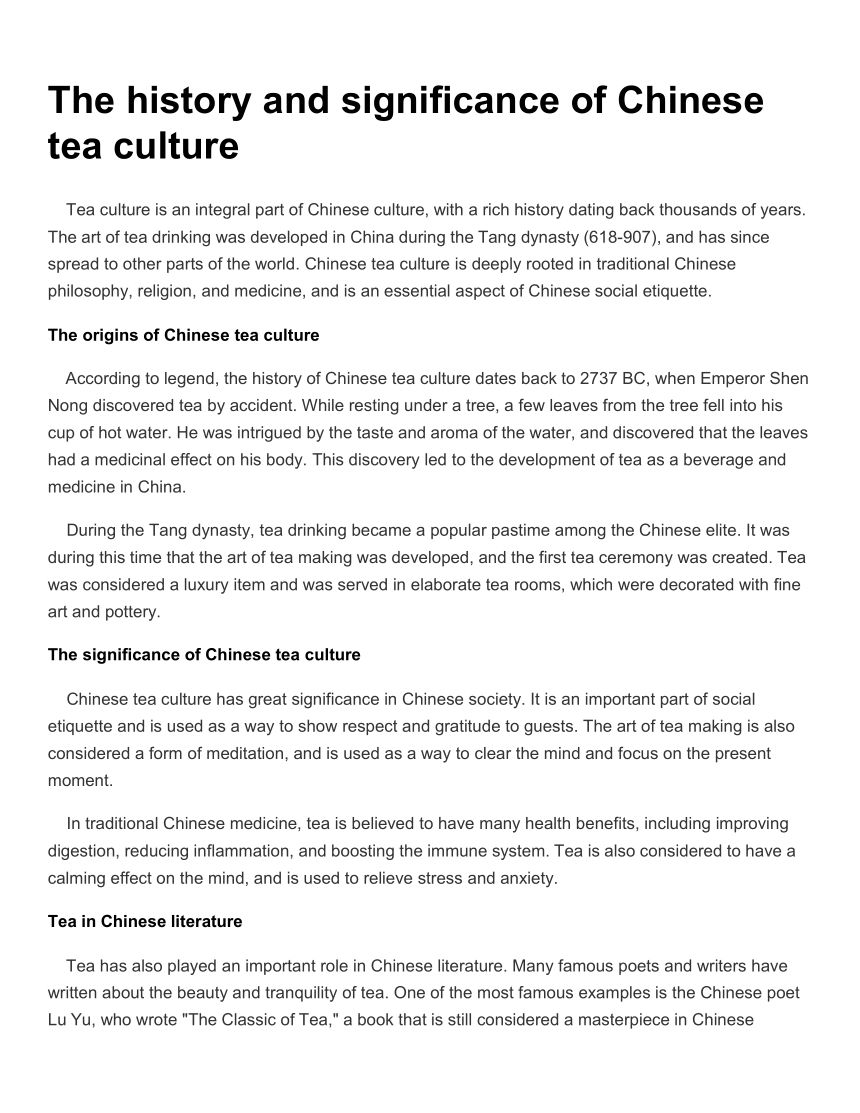 | |
| 格式 | docx | ||
| 文件大小 | 37.1KB | ||
| 资源类型 | 教案 | ||
| 版本资源 | 人教版(2019) | ||
| 科目 | 英语 | ||
| 更新时间 | 2023-02-20 23:59:05 | ||
图片预览

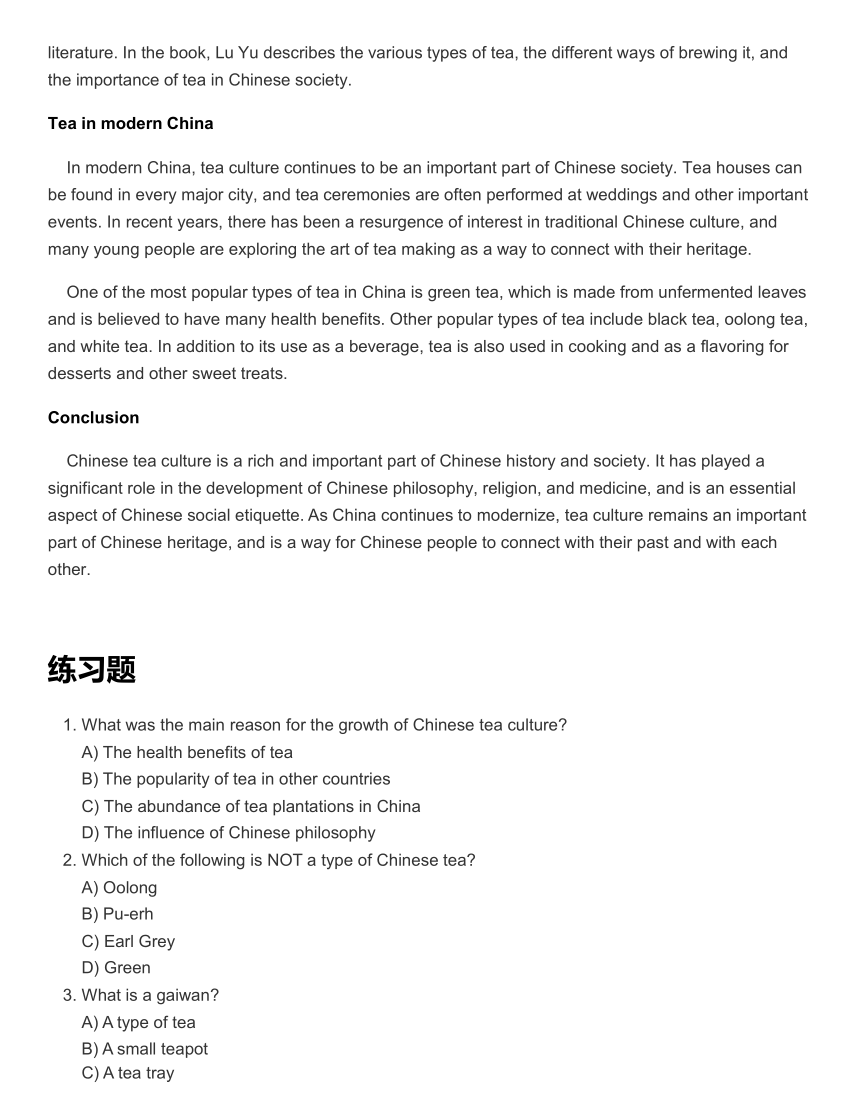
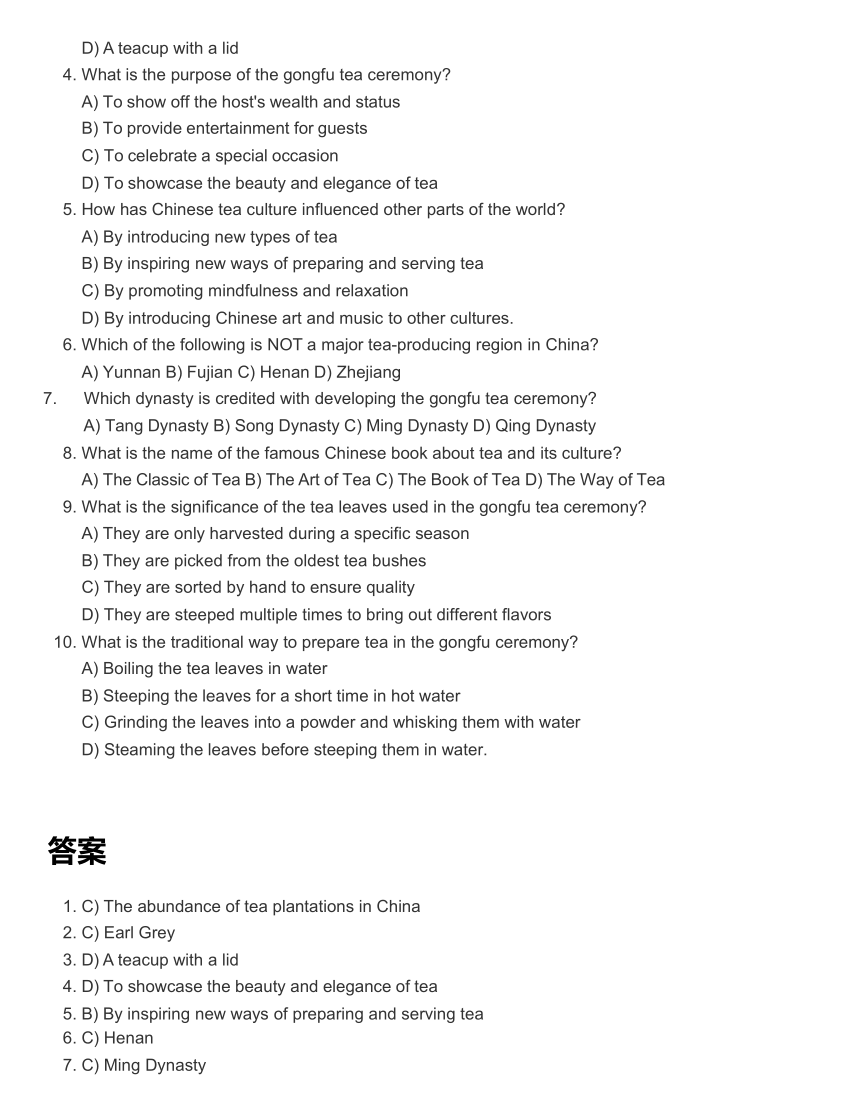
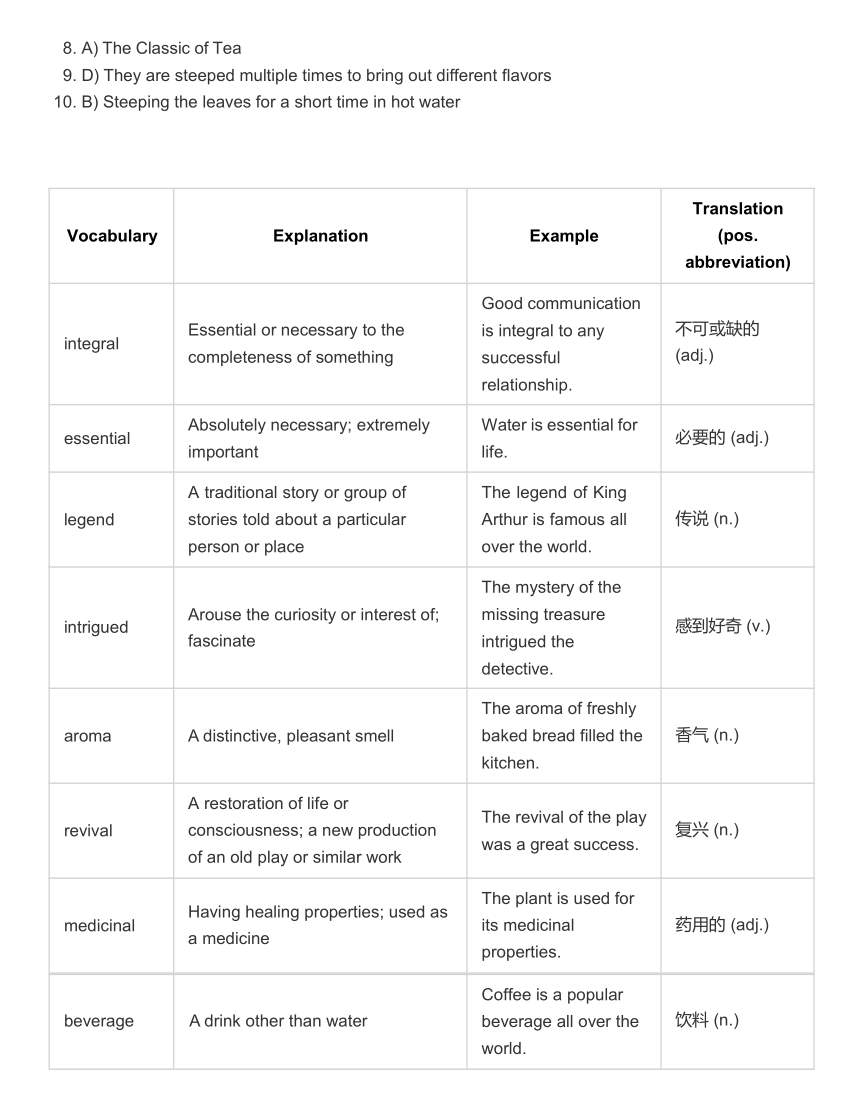
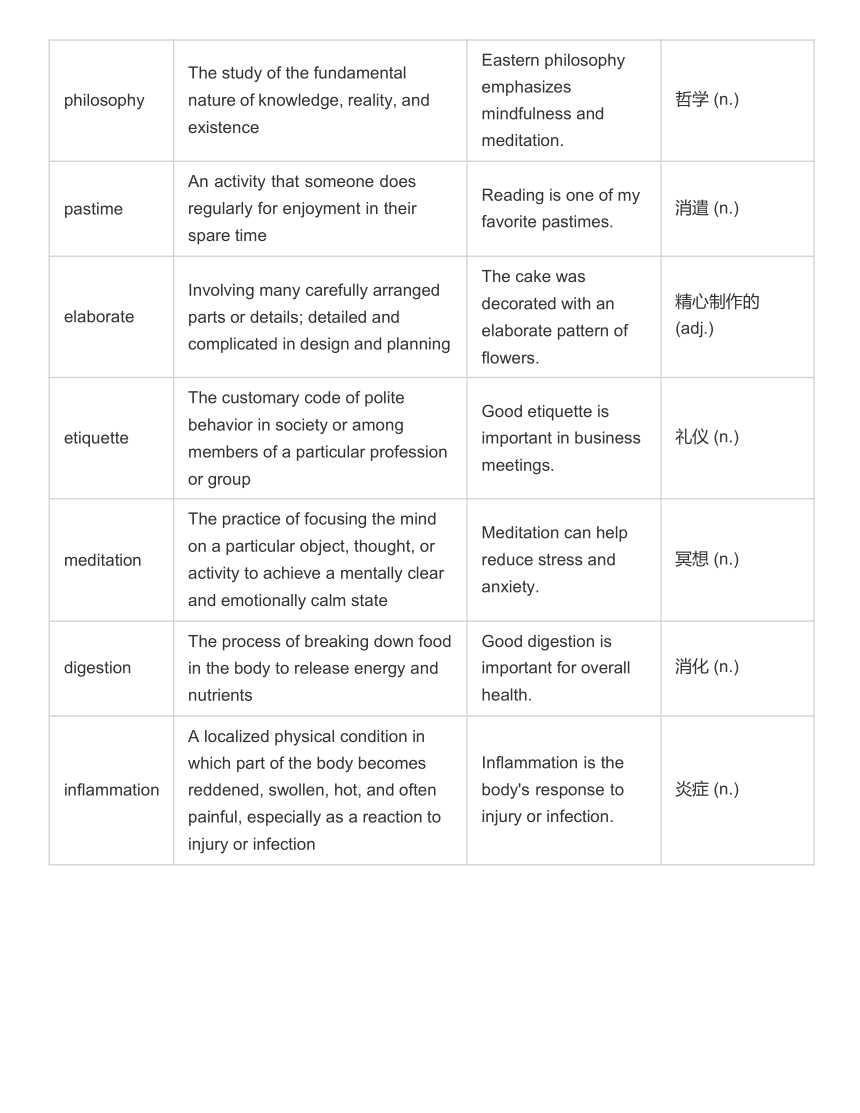
文档简介
The history and significance of Chinese tea culture
Tea culture is an integral part of Chinese culture, with a rich history dating back thousands of years.
The art of tea drinking was developed in China during the Tang dynasty (618-907), and has since spread to other parts of the world. Chinese tea culture is deeply rooted in traditional Chinese philosophy, religion, and medicine, and is an essential aspect of Chinese social etiquette.
The origins of Chinese tea culture
According to legend, the history of Chinese tea culture dates back to 2737 BC, when Emperor Shen Nong discovered tea by accident. While resting under a tree, a few leaves from the tree fell into his cup of hot water. He was intrigued by the taste and aroma of the water, and discovered that the leaves had a medicinal effect on his body. This discovery led to the development of tea as a beverage and medicine in China.
During the Tang dynasty, tea drinking became a popular pastime among the Chinese elite. It was during this time that the art of tea making was developed, and the first tea ceremony was created. Tea was considered a luxury item and was served in elaborate tea rooms, which were decorated with fine art and pottery.
The significance of Chinese tea culture
Chinese tea culture has great significance in Chinese society. It is an important part of social etiquette and is used as a way to show respect and gratitude to guests. The art of tea making is also considered a form of meditation, and is used as a way to clear the mind and focus on the present moment.
In traditional Chinese medicine, tea is believed to have many health benefits, including improving digestion, reducing inflammation, and boosting the immune system. Tea is also considered to have a calming effect on the mind, and is used to relieve stress and anxiety.
Tea in Chinese literature
Tea has also played an important role in Chinese literature. Many famous poets and writers have written about the beauty and tranquility of tea. One of the most famous examples is the Chinese poet Lu Yu, who wrote "The Classic of Tea," a book that is still considered a masterpiece in Chinese
literature. In the book, Lu Yu describes the various types of tea, the different ways of brewing it, and the importance of tea in Chinese society.
Tea in modern China
In modern China, tea culture continues to be an important part of Chinese society. Tea houses can be found in every major city, and tea ceremonies are often performed at weddings and other important events. In recent years, there has been a resurgence of interest in traditional Chinese culture, and many young people are exploring the art of tea making as a way to connect with their heritage.
One of the most popular types of tea in China is green tea, which is made from unfermented leaves and is believed to have many health benefits. Other popular types of tea include black tea, oolong tea, and white tea. In addition to its use as a beverage, tea is also used in cooking and as a flavoring for desserts and other sweet treats.
Conclusion
Chinese tea culture is a rich and important part of Chinese history and society. It has played a significant role in the development of Chinese philosophy, religion, and medicine, and is an essential aspect of Chinese social etiquette. As China continues to modernize, tea culture remains an important part of Chinese heritage, and is a way for Chinese people to connect with their past and with each other.
练习题
What was the main reason for the growth of Chinese tea culture
The health benefits of tea
The popularity of tea in other countries
The abundance of tea plantations in China
The influence of Chinese philosophy
Which of the following is NOT a type of Chinese tea
Oolong
Pu-erh
Earl Grey
Green
What is a gaiwan
A type of tea
A small teapot
A tea tray
A teacup with a lid
What is the purpose of the gongfu tea ceremony
To show off the host's wealth and status
To provide entertainment for guests
To celebrate a special occasion
To showcase the beauty and elegance of tea
How has Chinese tea culture influenced other parts of the world
By introducing new types of tea
By inspiring new ways of preparing and serving tea
By promoting mindfulness and relaxation
By introducing Chinese art and music to other cultures.
Which of the following is NOT a major tea-producing region in China
Yunnan B) Fujian C) Henan D) Zhejiang
Which dynasty is credited with developing the gongfu tea ceremony
Tang Dynasty B) Song Dynasty C) Ming Dynasty D) Qing Dynasty
What is the name of the famous Chinese book about tea and its culture
The Classic of Tea B) The Art of Tea C) The Book of Tea D) The Way of Tea
What is the significance of the tea leaves used in the gongfu tea ceremony
They are only harvested during a specific season
They are picked from the oldest tea bushes
They are sorted by hand to ensure quality
They are steeped multiple times to bring out different flavors
What is the traditional way to prepare tea in the gongfu ceremony
Boiling the tea leaves in water
Steeping the leaves for a short time in hot water
Grinding the leaves into a powder and whisking them with water
Steaming the leaves before steeping them in water.
答案
C) The abundance of tea plantations in China
C) Earl Grey
D) A teacup with a lid
D) To showcase the beauty and elegance of tea
B) By inspiring new ways of preparing and serving tea
C) Henan
C) Ming Dynasty
A) The Classic of Tea
D) They are steeped multiple times to bring out different flavors
B) Steeping the leaves for a short time in hot water
Vocabulary Explanation Example Translation (pos. abbreviation)
integral Essential or necessary to the completeness of something Good communication is integral to any successful relationship. 不可或缺的 (adj.)
essential Absolutely necessary; extremely important Water is essential for life. 必要的 (adj.)
legend A traditional story or group of stories told about a particular person or place The legend of King Arthur is famous all over the world. 传说 (n.)
intrigued Arouse the curiosity or interest of; fascinate The mystery of the missing treasure intrigued the detective. 感到好奇 (v.)
aroma A distinctive, pleasant smell The aroma of freshly baked bread filled the kitchen. 香气 (n.)
revival A restoration of life or consciousness; a new production of an old play or similar work The revival of the play was a great success. 复兴 (n.)
medicinal Having healing properties; used as a medicine The plant is used for its medicinal properties. 药用的 (adj.)
beverage A drink other than water Coffee is a popular beverage all over the world. 饮料 (n.)
philosophy The study of the fundamental nature of knowledge, reality, and existence Eastern philosophy emphasizes mindfulness and meditation. 哲学 (n.)
pastime An activity that someone does regularly for enjoyment in their spare time Reading is one of my favorite pastimes. 消遣 (n.)
elaborate Involving many carefully arranged parts or details; detailed and complicated in design and planning The cake was decorated with an elaborate pattern of flowers. 精心制作的 (adj.)
etiquette The customary code of polite behavior in society or among members of a particular profession or group Good etiquette is important in business meetings. 礼仪 (n.)
meditation The practice of focusing the mind on a particular object, thought, or activity to achieve a mentally clear and emotionally calm state Meditation can help reduce stress and anxiety. 冥想 (n.)
digestion The process of breaking down food in the body to release energy and nutrients Good digestion is important for overall health. 消化 (n.)
inflammation A localized physical condition in which part of the body becomes reddened, swollen, hot, and often painful, especially as a reaction to injury or infection Inflammation is the body's response to injury or infection. 炎症 (n.)
boosting Improve or increase something Exercise can help boost your energy levels. 提高 (v.)
literature Written works, especially those considered of superior or lasting artistic merit Shakespeare's works are considered classics of English literature. 文学 (n.)
brew Make (beer, coffee, or tea) by soaking, boiling, and fermentation I like to brew my coffee in a French press. 泡制 (v.)
heritage Features belonging to the culture of a particular society, such as traditions, languages, or buildings, that were created in the past and still have historical importance The Great Wall of China is an important part of Chinese heritage. 遗产 (n.)
unfermented Not having undergone the process of fermentation Green tea is unfermented tea. 未发酵的 (adj.)
outline
Introduction
Definition of Chinese tea culture Importance of Chinese tea culture Brief history of Chinese tea culture
The history of Chinese tea culture
The origins of Chinese tea culture The spread of Chinese tea culture
The development of Chinese tea culture
The significance of Chinese tea culture
The philosophy of Chinese tea culture
The social and cultural significance of Chinese tea culture The health benefits of drinking Chinese tea
The current situation of Chinese tea culture
The popularity of Chinese tea culture in China and abroad The challenges facing Chinese tea culture today
Efforts to preserve and promote Chinese tea culture
Conclusion
Recap of the history and significance of Chinese tea culture Final thoughts on the future of Chinese tea culture
Key Points
Introduction
Chinese tea culture is a set of customs and traditions related to the preparation and consumption of tea in China.
Chinese tea culture has been an integral part of Chinese life for centuries. Chinese tea culture has a long and rich history.
The history of Chinese tea culture
Chinese tea culture dates back to ancient times, with the first recorded use of tea in China dating back to the Han dynasty (206 BCE – 220 CE).
Chinese tea culture gradually spread throughout China and beyond, with tea eventually becoming a major commodity for international trade.
Chinese tea culture has evolved over time, with different regions in China developing their own unique tea cultures and traditions.
The significance of Chinese tea culture
Chinese tea culture reflects Chinese philosophy, values, and aesthetics.
Tea plays an important role in Chinese social and cultural life, with tea ceremonies and tea houses being popular gathering places.
Chinese tea has a number of health benefits, including aiding digestion and reducing inflammation.
The current situation of Chinese tea culture
Chinese tea culture is still popular in China, with many people continuing to practice traditional tea-making techniques.
Chinese tea culture faces challenges from modernization and changing cultural norms.
Efforts are being made to preserve and promote Chinese tea culture, including through tourism and cultural exchange programs.
Conclusion
Chinese tea culture is an important part of Chinese history and culture, reflecting the values and aesthetics of Chinese society.
Despite facing challenges, Chinese tea culture continues to be an important part of Chinese life and is being preserved and promoted for future generations.
叙事短文
It was a beautiful Sunday morning, and as usual, Emily was up early. She had been looking forward to this day for a long time. Today was the day of her tea ceremony class, and she couldn't wait to learn more about Chinese tea culture.
Emily had always been fascinated by the elegance and simplicity of Chinese tea ceremonies. She
loved the way that the whole process of making and drinking tea was a way of connecting with nature and finding inner peace. Emily had grown up in a busy city, and she often found herself feeling stressed and overwhelmed by the hustle and bustle of modern life. She hoped that learning more about Chinese tea culture would help her find a sense of calm and tranquility.
As Emily arrived at the tea ceremony class, she was greeted by the teacher, a wise and gentle woman named Mrs. Chen. Mrs. Chen led Emily to a small room with a low table, surrounded by cushions.
Emily sat down and looked around in wonder as Mrs. Chen began to prepare the tea.
The whole process was so different from the way that Emily was used to making tea. Mrs. Chen carefully measured out the tea leaves, boiled the water to the perfect temperature, and then poured
the water over the leaves with a graceful and deliberate movement. As the tea steeped, Mrs. Chen explained the history and significance of Chinese tea culture, telling Emily stories about the ancient tea masters and the way that tea had been used to promote health and wellbeing for centuries.
As they sipped their tea, Emily felt a sense of peace and serenity that she had never experienced before. The simple act of drinking tea had become a meditation, a way of connecting with herself and the world around her. As the class came to an end, Emily felt a sense of gratitude and wonder. She knew that she would continue to explore the world of Chinese tea, using it as a way of finding peace and balance in her modern life.
What fascinated Emily about Chinese tea ceremonies
The complicated steps involved
The elegance and simplicity
The historical significance
The expensive tea sets
What did Emily hope to gain from learning about Chinese tea culture
A greater appreciation for Chinese history
The ability to make the perfect cup of tea
A sense of calm and tranquility
The opportunity to meet new people
Where did Emily attend her tea ceremony class
At a traditional tea house
In a park
At her friend's house
Online
What kind of person was Emily's tea ceremony instructor
A strict and demanding teacher
A young and inexperienced student
A wise and gentle woman
A business executive
What did Emily feel after the tea ceremony
Tired and bored
Disappointed in herself
Relaxed and at peace
Inspired to become a tea master
Answers
B) The elegance and simplicity
C) A sense of calm and tranquility
A) At a traditional tea house
C) A wise and gentle woman
C) Relaxed and at peace
短语
No. Vocabulary Translation (Chinese)
1. fascinated by 迷住,着迷
2. elegance and simplicity 优雅和简洁
3. surrounded by cushions 坐在垫子上
4. graceful and deliberate movement 优美而有意的动作
5. promote health and wellbeing 促进健康和福祉
6. sense of peace and serenity 平静和宁静的感觉
Tea culture is an integral part of Chinese culture, with a rich history dating back thousands of years.
The art of tea drinking was developed in China during the Tang dynasty (618-907), and has since spread to other parts of the world. Chinese tea culture is deeply rooted in traditional Chinese philosophy, religion, and medicine, and is an essential aspect of Chinese social etiquette.
The origins of Chinese tea culture
According to legend, the history of Chinese tea culture dates back to 2737 BC, when Emperor Shen Nong discovered tea by accident. While resting under a tree, a few leaves from the tree fell into his cup of hot water. He was intrigued by the taste and aroma of the water, and discovered that the leaves had a medicinal effect on his body. This discovery led to the development of tea as a beverage and medicine in China.
During the Tang dynasty, tea drinking became a popular pastime among the Chinese elite. It was during this time that the art of tea making was developed, and the first tea ceremony was created. Tea was considered a luxury item and was served in elaborate tea rooms, which were decorated with fine art and pottery.
The significance of Chinese tea culture
Chinese tea culture has great significance in Chinese society. It is an important part of social etiquette and is used as a way to show respect and gratitude to guests. The art of tea making is also considered a form of meditation, and is used as a way to clear the mind and focus on the present moment.
In traditional Chinese medicine, tea is believed to have many health benefits, including improving digestion, reducing inflammation, and boosting the immune system. Tea is also considered to have a calming effect on the mind, and is used to relieve stress and anxiety.
Tea in Chinese literature
Tea has also played an important role in Chinese literature. Many famous poets and writers have written about the beauty and tranquility of tea. One of the most famous examples is the Chinese poet Lu Yu, who wrote "The Classic of Tea," a book that is still considered a masterpiece in Chinese
literature. In the book, Lu Yu describes the various types of tea, the different ways of brewing it, and the importance of tea in Chinese society.
Tea in modern China
In modern China, tea culture continues to be an important part of Chinese society. Tea houses can be found in every major city, and tea ceremonies are often performed at weddings and other important events. In recent years, there has been a resurgence of interest in traditional Chinese culture, and many young people are exploring the art of tea making as a way to connect with their heritage.
One of the most popular types of tea in China is green tea, which is made from unfermented leaves and is believed to have many health benefits. Other popular types of tea include black tea, oolong tea, and white tea. In addition to its use as a beverage, tea is also used in cooking and as a flavoring for desserts and other sweet treats.
Conclusion
Chinese tea culture is a rich and important part of Chinese history and society. It has played a significant role in the development of Chinese philosophy, religion, and medicine, and is an essential aspect of Chinese social etiquette. As China continues to modernize, tea culture remains an important part of Chinese heritage, and is a way for Chinese people to connect with their past and with each other.
练习题
What was the main reason for the growth of Chinese tea culture
The health benefits of tea
The popularity of tea in other countries
The abundance of tea plantations in China
The influence of Chinese philosophy
Which of the following is NOT a type of Chinese tea
Oolong
Pu-erh
Earl Grey
Green
What is a gaiwan
A type of tea
A small teapot
A tea tray
A teacup with a lid
What is the purpose of the gongfu tea ceremony
To show off the host's wealth and status
To provide entertainment for guests
To celebrate a special occasion
To showcase the beauty and elegance of tea
How has Chinese tea culture influenced other parts of the world
By introducing new types of tea
By inspiring new ways of preparing and serving tea
By promoting mindfulness and relaxation
By introducing Chinese art and music to other cultures.
Which of the following is NOT a major tea-producing region in China
Yunnan B) Fujian C) Henan D) Zhejiang
Which dynasty is credited with developing the gongfu tea ceremony
Tang Dynasty B) Song Dynasty C) Ming Dynasty D) Qing Dynasty
What is the name of the famous Chinese book about tea and its culture
The Classic of Tea B) The Art of Tea C) The Book of Tea D) The Way of Tea
What is the significance of the tea leaves used in the gongfu tea ceremony
They are only harvested during a specific season
They are picked from the oldest tea bushes
They are sorted by hand to ensure quality
They are steeped multiple times to bring out different flavors
What is the traditional way to prepare tea in the gongfu ceremony
Boiling the tea leaves in water
Steeping the leaves for a short time in hot water
Grinding the leaves into a powder and whisking them with water
Steaming the leaves before steeping them in water.
答案
C) The abundance of tea plantations in China
C) Earl Grey
D) A teacup with a lid
D) To showcase the beauty and elegance of tea
B) By inspiring new ways of preparing and serving tea
C) Henan
C) Ming Dynasty
A) The Classic of Tea
D) They are steeped multiple times to bring out different flavors
B) Steeping the leaves for a short time in hot water
Vocabulary Explanation Example Translation (pos. abbreviation)
integral Essential or necessary to the completeness of something Good communication is integral to any successful relationship. 不可或缺的 (adj.)
essential Absolutely necessary; extremely important Water is essential for life. 必要的 (adj.)
legend A traditional story or group of stories told about a particular person or place The legend of King Arthur is famous all over the world. 传说 (n.)
intrigued Arouse the curiosity or interest of; fascinate The mystery of the missing treasure intrigued the detective. 感到好奇 (v.)
aroma A distinctive, pleasant smell The aroma of freshly baked bread filled the kitchen. 香气 (n.)
revival A restoration of life or consciousness; a new production of an old play or similar work The revival of the play was a great success. 复兴 (n.)
medicinal Having healing properties; used as a medicine The plant is used for its medicinal properties. 药用的 (adj.)
beverage A drink other than water Coffee is a popular beverage all over the world. 饮料 (n.)
philosophy The study of the fundamental nature of knowledge, reality, and existence Eastern philosophy emphasizes mindfulness and meditation. 哲学 (n.)
pastime An activity that someone does regularly for enjoyment in their spare time Reading is one of my favorite pastimes. 消遣 (n.)
elaborate Involving many carefully arranged parts or details; detailed and complicated in design and planning The cake was decorated with an elaborate pattern of flowers. 精心制作的 (adj.)
etiquette The customary code of polite behavior in society or among members of a particular profession or group Good etiquette is important in business meetings. 礼仪 (n.)
meditation The practice of focusing the mind on a particular object, thought, or activity to achieve a mentally clear and emotionally calm state Meditation can help reduce stress and anxiety. 冥想 (n.)
digestion The process of breaking down food in the body to release energy and nutrients Good digestion is important for overall health. 消化 (n.)
inflammation A localized physical condition in which part of the body becomes reddened, swollen, hot, and often painful, especially as a reaction to injury or infection Inflammation is the body's response to injury or infection. 炎症 (n.)
boosting Improve or increase something Exercise can help boost your energy levels. 提高 (v.)
literature Written works, especially those considered of superior or lasting artistic merit Shakespeare's works are considered classics of English literature. 文学 (n.)
brew Make (beer, coffee, or tea) by soaking, boiling, and fermentation I like to brew my coffee in a French press. 泡制 (v.)
heritage Features belonging to the culture of a particular society, such as traditions, languages, or buildings, that were created in the past and still have historical importance The Great Wall of China is an important part of Chinese heritage. 遗产 (n.)
unfermented Not having undergone the process of fermentation Green tea is unfermented tea. 未发酵的 (adj.)
outline
Introduction
Definition of Chinese tea culture Importance of Chinese tea culture Brief history of Chinese tea culture
The history of Chinese tea culture
The origins of Chinese tea culture The spread of Chinese tea culture
The development of Chinese tea culture
The significance of Chinese tea culture
The philosophy of Chinese tea culture
The social and cultural significance of Chinese tea culture The health benefits of drinking Chinese tea
The current situation of Chinese tea culture
The popularity of Chinese tea culture in China and abroad The challenges facing Chinese tea culture today
Efforts to preserve and promote Chinese tea culture
Conclusion
Recap of the history and significance of Chinese tea culture Final thoughts on the future of Chinese tea culture
Key Points
Introduction
Chinese tea culture is a set of customs and traditions related to the preparation and consumption of tea in China.
Chinese tea culture has been an integral part of Chinese life for centuries. Chinese tea culture has a long and rich history.
The history of Chinese tea culture
Chinese tea culture dates back to ancient times, with the first recorded use of tea in China dating back to the Han dynasty (206 BCE – 220 CE).
Chinese tea culture gradually spread throughout China and beyond, with tea eventually becoming a major commodity for international trade.
Chinese tea culture has evolved over time, with different regions in China developing their own unique tea cultures and traditions.
The significance of Chinese tea culture
Chinese tea culture reflects Chinese philosophy, values, and aesthetics.
Tea plays an important role in Chinese social and cultural life, with tea ceremonies and tea houses being popular gathering places.
Chinese tea has a number of health benefits, including aiding digestion and reducing inflammation.
The current situation of Chinese tea culture
Chinese tea culture is still popular in China, with many people continuing to practice traditional tea-making techniques.
Chinese tea culture faces challenges from modernization and changing cultural norms.
Efforts are being made to preserve and promote Chinese tea culture, including through tourism and cultural exchange programs.
Conclusion
Chinese tea culture is an important part of Chinese history and culture, reflecting the values and aesthetics of Chinese society.
Despite facing challenges, Chinese tea culture continues to be an important part of Chinese life and is being preserved and promoted for future generations.
叙事短文
It was a beautiful Sunday morning, and as usual, Emily was up early. She had been looking forward to this day for a long time. Today was the day of her tea ceremony class, and she couldn't wait to learn more about Chinese tea culture.
Emily had always been fascinated by the elegance and simplicity of Chinese tea ceremonies. She
loved the way that the whole process of making and drinking tea was a way of connecting with nature and finding inner peace. Emily had grown up in a busy city, and she often found herself feeling stressed and overwhelmed by the hustle and bustle of modern life. She hoped that learning more about Chinese tea culture would help her find a sense of calm and tranquility.
As Emily arrived at the tea ceremony class, she was greeted by the teacher, a wise and gentle woman named Mrs. Chen. Mrs. Chen led Emily to a small room with a low table, surrounded by cushions.
Emily sat down and looked around in wonder as Mrs. Chen began to prepare the tea.
The whole process was so different from the way that Emily was used to making tea. Mrs. Chen carefully measured out the tea leaves, boiled the water to the perfect temperature, and then poured
the water over the leaves with a graceful and deliberate movement. As the tea steeped, Mrs. Chen explained the history and significance of Chinese tea culture, telling Emily stories about the ancient tea masters and the way that tea had been used to promote health and wellbeing for centuries.
As they sipped their tea, Emily felt a sense of peace and serenity that she had never experienced before. The simple act of drinking tea had become a meditation, a way of connecting with herself and the world around her. As the class came to an end, Emily felt a sense of gratitude and wonder. She knew that she would continue to explore the world of Chinese tea, using it as a way of finding peace and balance in her modern life.
What fascinated Emily about Chinese tea ceremonies
The complicated steps involved
The elegance and simplicity
The historical significance
The expensive tea sets
What did Emily hope to gain from learning about Chinese tea culture
A greater appreciation for Chinese history
The ability to make the perfect cup of tea
A sense of calm and tranquility
The opportunity to meet new people
Where did Emily attend her tea ceremony class
At a traditional tea house
In a park
At her friend's house
Online
What kind of person was Emily's tea ceremony instructor
A strict and demanding teacher
A young and inexperienced student
A wise and gentle woman
A business executive
What did Emily feel after the tea ceremony
Tired and bored
Disappointed in herself
Relaxed and at peace
Inspired to become a tea master
Answers
B) The elegance and simplicity
C) A sense of calm and tranquility
A) At a traditional tea house
C) A wise and gentle woman
C) Relaxed and at peace
短语
No. Vocabulary Translation (Chinese)
1. fascinated by 迷住,着迷
2. elegance and simplicity 优雅和简洁
3. surrounded by cushions 坐在垫子上
4. graceful and deliberate movement 优美而有意的动作
5. promote health and wellbeing 促进健康和福祉
6. sense of peace and serenity 平静和宁静的感觉
